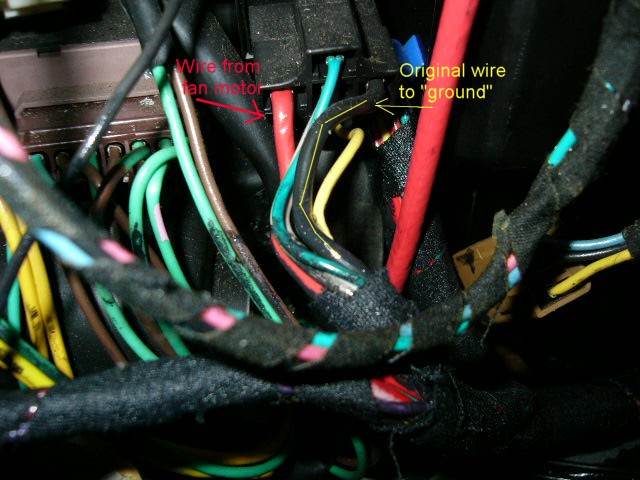|
|
||
| The fan on the CX operates on a
ground-switched circuit. The power supplied to the fan is
provided straight from the battery, via a relay. The fan speed is controlled by varying the
resistance in the path from the fan to the ground point. The path to ground runs through a SPDT relay. For all
speeds less than maximum, the relay routes power through a set of
resistors; this allows for the variation in fan speeds. At maximum, the
relay routes power directly to "ground" Unfortunately, as in many
other circuits on Citroens, "Ground" is off in some never-never land,
unknown to mankind. There is a wire from the relay, but it runs
off somewhere through the firewall, never to be found. There are
many instances on the CX where a ground wire is connected into another
wire, which ends up a grounding point that is too far away, through a
gauge that is too small. Rich Hollabaugh had the good sense to test this
mysterious wire, and discovered a notable voltage drop in a circuit that should
have a minimal drop.
Luckily, there is a good grounding point very close to the relay, under the handbrake / stereo console. It's very easy to run a new 12G wire from the relay to this grounding point, enabling a less-resistant path through to ground.
|
Le pulseur sur la CX est réglé
par un rhéostat dans le circuit entre le pulseur et la masse.
L'électricité pour alimenter le pulseur vient directement de la batterie.
La vitesse du pulseur est variée par l'augmentation de la résistance
entre le pulseur et la masse. Un relais SPDT est dédie à ce circuit.
Pour toute vitesse inférieure au maxi, le relais dirige l'électricité a
travers des résisteurs. Pour la vitesse maxi, l'électricité va
directement a la masse. Mais, comme plusieurs autres circuits Citroën,
la masse est loin du pulseur. La réparation est simple: faire passer
l'électricité a la masse par la voie la plus courte que possible.
Heureusement, il y a un point de masse bien proche au relais, au-dessous le frein a main. Diriger un fil épais du relais au point de masse, c'est un jeu d'enfant.
|
|
| Here's a view of the relay in its location. It is in the center console, directly under the temperature control thumbwheel. I removed the starboard side of both the center console, and the handbrake / stereo console. | En voici une vue du relais dans son endroit. C'est dans la console central, au-dessous du rouleau de réglage de température. J'ai enlevé la cote droite de la console, y compris le console autour du frein a main. | |
|
|
||
| Here's a closer view. The red wire delivers power from the fan. The black wire runs straight to ground. The grey ( I think it was grey) wire goes through the resistors to regulate fan speeds at less than maximum. I checked the grey and black wires before making any cuts. If I had put the grey wire directly to ground, then there would be no regulation of fan speed at all. It would at maximum speed all the time. Certainly not the desired effect. | En voici une vue plus proche. Le fil rouge vient du pulseur. Le fil noir est branché à la masse. Le fil gris amène l'électricité à travers les résisteurs à fin de régler la vitesse du pulseur. J'ai bien vérifié que le gris présentait une résistance qui variait avec la position du rouleau de vitesse du pulseur, et que le noir n'offrait aucune variance. | |
 |
||
| I cut the wire to "ground" and butt-connected a new 12G wire which I ran directly to the chassis grounding point under the handbrake. Here's the installation. Note the difference in gauge between the ground wire I added, and the factory wires grounded at the same point. | J'ai coupé le fil vers la "masse" inconnue et y branché un fil épais que j'ai dirigé directement au point de masse au-dessous du frein a main. On constate la différence entre l'épaisseur du fil neuf (le noir) et l'épaisseur des autres fils jaunes, ces dernières installés par l'usine. | |
|
|
||